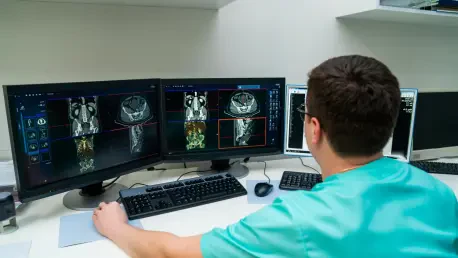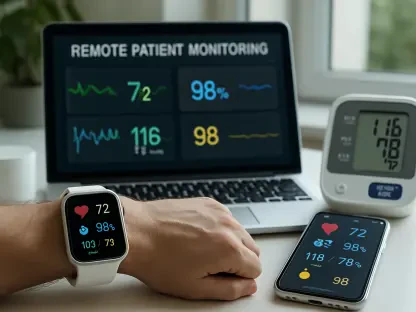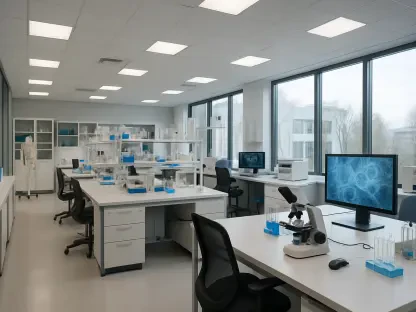In the evolving landscape of medical diagnostics, contrast media have become indispensable tools in facilitating detailed visualization of internal body structures, thereby aiding accurate diagnoses. These substances, often iodine and gadolinium-based, enhance the clarity of imaging techniques such as X-rays, MRIs, and CT scans, making them vital in modern healthcare. The contrast media market, currently projected to grow at a compound annual growth rate (CAGR) of 5-6% by 2029, is poised for significant advancement driven by several key factors. Increasing global healthcare spending and the rising demand for advanced imaging processes contribute notably to this growth trajectory. As medical technology advances, the need for sophisticated contrast media to keep pace with new diagnostic techniques becomes even more crucial, underpinned by continuous innovations in the field.
Factors Contributing to Market Growth
Rise in Chronic Diseases and Advanced Imaging Needs
The increasing prevalence of chronic illnesses such as cardiovascular diseases, cancer, and neurological disorders has sharply amplified the necessity for high-quality imaging. These conditions often require frequent, detailed imaging for effective diagnosis and management, propelling the demand for enhanced contrast media. As these diseases continue to rise, particularly in aging populations globally, the healthcare sector sees a consistent increase in routine imaging procedures. This surge is not only a response to immediate diagnostic needs but also an acknowledgment of the crucial role that early detection and intervention play in managing these complex conditions. Alongside this, there is growing awareness about the importance of preventive healthcare, further stimulating the demand for superior imaging solutions.
The correlation between advanced imaging technologies and increasing diagnosis rates reinforces the need for cutting-edge contrast media. As healthcare systems globally place a heightened focus on early disease detection, sophisticated contrast media are critical in meeting these demands. Furthermore, the expansion of healthcare infrastructure in both developed and emerging economies translates to increased accessibility and affordability of diagnostic procedures, contributing significantly to the market’s growth. With these elements in play, contrast media manufacturers are incentivized to innovate continually, creating new formulations that offer improved efficacy and safety profiles.
Impact of Demographic Shifts and Healthcare Spending
Demographic changes, particularly the rise of the global elderly population, significantly influence the dynamics of the contrast media market. Older adults are more susceptible to age-related illnesses that demand regular and comprehensive imaging, thereby driving increased demand for contrast media. This demographic trend coincides with climbing healthcare expenditures worldwide, focusing on expanding medical services and technological capabilities. Consequently, the integration of advanced diagnostics in routine healthcare practices is increasingly common, necessitating the adaptation and enhancement of contrast media to support these advancements.
Increased investments in healthcare systems, particularly in emerging markets, contribute to market expansion by improving access to diagnostic imaging technologies. As these regions continue to modernize their healthcare infrastructure, the demand for contrast media escalates, reflecting broader global trends towards enhanced medical services. Such an environment fosters a competitive landscape wherein manufacturers are keen on delivering innovative solutions that cater to the varying needs of diverse populations. The combination of strategic healthcare investments and demographic shifts emphasizes the importance of adaptable and high-performance contrast media, forming a solid foundation for ongoing market growth.
Technological Innovations and Their Impact
Development of Nanoparticle-Based Contrast Agents
Innovation in nanoparticle-based contrast agents marks a significant milestone in advancing the contrast media market. These agents are designed to target specific tissues, improving imaging resolution and diagnostic accuracy. By reducing the required volume of contrast media, nanoparticle-based agents also address safety and efficiency concerns, limiting exposure and side effects. This innovation aligns closely with the ongoing trend toward more precise and less invasive diagnostic procedures, delivering substantial benefits in terms of patient safety and care quality.
The versatility of nanoparticle-based agents extends to their potential in multiparametric imaging techniques, which combine various imaging modalities for a comprehensive diagnostic overview. This approach necessitates tailored contrast agents capable of functioning across these different imaging platforms, further underscoring the importance of innovation in contrast media. Meanwhile, partnerships between tech companies and healthcare providers facilitate the integration of these advanced agents into existing imaging systems, promising enhanced diagnostic outcomes. The ongoing development of nanoparticle-based contrast agents exemplifies the market’s focus on leveraging technology to meet evolving diagnostic demands.
Integration of Biodegradable Agents and Artificial Intelligence
The introduction of biodegradable contrast agents represents a crucial shift toward more environmentally friendly and patient-safe solutions. These agents are designed for easy metabolism and elimination, reducing the risk of adverse reactions and environmental impact associated with traditional contrast media. Such advancements underscore the healthcare sector’s commitment to sustainability and patient safety, offering promising alternatives to conventional products. Additionally, the integration of artificial intelligence (AI) into imaging systems further enhances contrast media’s effectiveness by improving visibility and aiding in precise diagnosis.
AI’s role in augmenting diagnostic capabilities extends beyond merely enhancing contrast; it allows for a more nuanced interpretation of complex medical images. By streamlining the analysis process, AI-driven technologies can potentially transform how contrast media are utilized in practice, offering quicker and more accurate results. As these technologies continue to evolve, so does the expectation for contrast media to deliver superior performance in conjunction with AI-enhanced imaging systems. This dynamic interplay between technology and medicine exemplifies the forward-thinking approaches driving the contrast media market’s growth.
Personalized Medicine and Market Challenges
Embracing Personalized Imaging Solutions
The concept of personalized medicine is gaining momentum in the contrast media industry, where imaging solutions are being tailored to individual patient characteristics such as age, gender, and medical history. This approach optimizes diagnostic outcomes by customizing the contrast media used, thereby increasing diagnostic accuracy while minimizing potential risks. Personalized imaging solutions employ advanced algorithms and patient-specific data to determine the optimal contrast agent type and dosage, reflecting a commitment to improving patient care.
Alongside enhancements in personalization, the development of portable imaging devices facilitates point-of-care diagnostics, allowing contrast-enhanced procedures to be conducted in various settings like outpatient clinics or at a patient’s bedside. This flexibility improves the speed and efficiency of diagnostic processes, benefiting both healthcare providers and patients. The evolution of personalized medicine aligns with broader shifts toward patient-centered care, demonstrating the contrast media market’s adaptability to changing healthcare paradigms. Such advancements not only enhance diagnostic precision but also pave the way for more equitable healthcare access.
Addressing Regulatory and Environmental Concerns
Despite the innovations and growth opportunities, the contrast media market faces considerable challenges. Regulatory hurdles remain a significant obstacle, with approval processes often being lengthier and standards evolving at a rapid pace. These hurdles can complicate market entry and delay the introduction of new products to the market. Furthermore, the safety of contrast media, while generally assured, necessitates careful monitoring to prevent adverse reactions, highlighting the importance of ongoing research and development.
Environmental implications of traditional contrast media have also drawn scrutiny, prompting the need for greener alternatives. As the industry seeks to address these concerns, there is increased focus on developing biodegradable and sustainable contrast agents. The rising costs associated with acquiring advanced imaging technologies can also hinder market access, particularly in resource-limited settings, emphasizing the necessity for cost-effective solutions. Strategic collaborations between key players in the industry offer a pathway to overcoming these obstacles, showcasing a concerted effort to align innovation with regulatory and environmental needs.
Global Market Landscape and Competitive Dynamics
Regional Market Leaders and Influencers
The contrast media market exhibits varied dynamics across different regions, each influenced by its own unique factors. North America holds a leading position, driven by a strong manufacturing presence, robust healthcare infrastructure, and significant research activities. The region’s high incidence of chronic diseases further fuels the demand for innovative diagnostic procedures, reinforcing its status as a market leader. Similarly, Europe remains a significant player, bolstered by favorable government policies and a focus on early disease detection through cutting-edge imaging technologies.
In contrast, the Asia Pacific region is witnessing rapid expansion attributed to its improving healthcare infrastructure and rising income levels. This growth is evidenced by increasing investments in medical imaging technologies, with countries such as China, Japan, India, and South Korea emerging as key markets. These nations benefit from large patient populations and expanding healthcare facilities, catalyzed by efforts to modernize healthcare systems and the prevalence of chronic diseases. Consequently, the region’s burgeoning market potential is attracting attention from global contrast media manufacturers eager to tap into these opportunities.
Strategic Growth and Industry Collaborations
The rising incidence of chronic diseases such as cardiovascular issues, cancer, and neurological disorders has significantly increased the need for high-quality imaging solutions. These complex conditions often necessitate frequent and detailed imaging for accurate diagnosis and efficient management, driving demand for advanced contrast media. As these diseases become more prevalent, especially among aging populations worldwide, there is a marked growth in routine imaging procedures. This surge is not only a response to urgent diagnostic requirements but also an acknowledgment of the crucial role that early detection and timely intervention play in handling these intricate health challenges. Moreover, a growing awareness of preventive healthcare further drives the demand for superior imaging technologies.
The relationship between cutting-edge imaging technologies and higher diagnosis rates underscores the necessity for advanced contrast media. Globally, healthcare systems are increasingly prioritizing early disease detection, making sophisticated contrast media essential to meet these needs. Additionally, the expansion of healthcare infrastructure in both developed and developing regions enhances the accessibility and affordability of diagnostic procedures, contributing greatly to the growth of the market. With these factors at play, manufacturers of contrast media are motivated to innovate continuously, developing new formulations that enhance efficacy and safety profiles.









